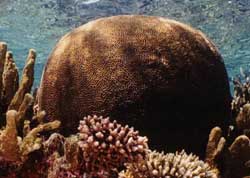

The coral reefs are known for the colorful fish and marine life that live within them, the reefs themselves are actually made up of tiny animals called polyps, which create cup-like limestone skeletons around themselves using calcium from seawater. Reefs form as generation after generation of coral polyps live, build, and die, creating vast strongholds for themselves and many other plants and animals.
Coral reefs may take hundreds, even thousands, of years to form, typically growing as slowly as 5 millimeters and no more than 20 centimeters per year. Coral reefs evolved some 200 million years ago, and today, most reefs age between 5,000 and 10,000 years old. But what has taken centuries to build can be destroyed instantly.
Human activity is one of the bigest threats to Coral Reefs because has destroyed more than 35 million acres of coral reefs. Despite their protection in national parks, coral reefs in the United States face many of the threats suffered by reef ecosystems worldwide.Coral bleaching refers to a process in which corals expel the algal cells (zooxanthellae) that normally live within their tissue. These algae give corals their characteristic brownish and once they have been expelled, the white skeleton shows through a coralŐs transparent tissue, giving it a bleached white appearance. Bleached coral looks very similar to coral that has recently died, but can be distinguished (on close inspection) by the presence of small polyps and tentacles on the coral surface. Coral bleaching can be caused by stressful environmental conditions such as extreme temperature, low salinity, extreme light and various toxins. However, large-scale bleaching episodes are usually associated with unusually high sea temperatures. This relationship has led to the suggestions that coral reefs are showing early signs of stress due to global warming caused by green house gas emissions.
Bleached corals are still alive and can recover fully if the stressful conditions are not too severe or prolonged. However massive coral mortality is a feature of many severe bleaching episodes. The events of 1982/83 and 1998 in particular resulted in wide spread mortality of some coral in some areas. Following milder bleaching events, most coral recover their health, but this may take several months, and can result in lower growth and abnormal reproduction for some time after normal color has returned.
Some sites for coral reef conservation: Reef Relief, The Coral Reef Alliance, Funding Available for Coral Reef Conservation Projects, NFWF Coral Reef Conservation Fund, Coral reef Destruction and Conservation